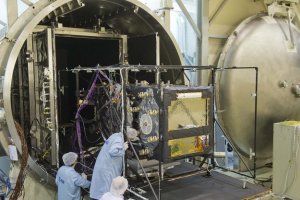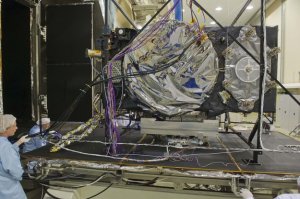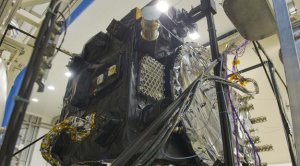The first of the two Galileo FOC satellites (FM1) has been under testing since May 2013 in simulated space conditions.
In late October the phone box-sixed satellite was placed in the 4.5 m-diameter Phenix chamber (stainless steel vacuum chamber) in ESA’s ESTEC Test Centre in Noordwijk, the Netherlands, the largest spacecraft testing facility in Europe, with a full range of space simulation facilities under a single roof in cleanroom conditions. Once inside, the air was pumped out to create a space-quality vacuum at the same time as the temperature extremes in Galileo’s planned orbit were also reproduced.
An inner box called the “thermal tent” has sides that are heated to simulate the Sun’s radiation or cooled down by liquid nitrogen to create the chill of Sunless space. The six copper walls of the ‘thermal tent’ were independently cooled by liquid nitrogen down to the –180°C chill of sunless space.
With no air to transfer heat, the opposing sides of satellites in space can become very hot and very cold simultaneously, depending on whether they are in sunlight or shadow. Anyway, the satellite must still work perfectly, in terms of performances of the two atomic clocks within the Galileo satellite.
Thermal control is a critical design concern, seeking to maintain a set operating temperature within the body of the satellite. This is why some of Galileo’s surfaces are covered with reflective mirrors and others by black multilayer insulation.
The satellite was operated and monitored throughout the long test 24 hours a day by technicians working around the clock. Galileo’s internal temperatures and subsystem performance were tracked continuously.
The thermal-vacuum test was the culmination of a long session of testing stretching back to mid-May, when it first arrived at ESTEC. These included simulating the violence of launch and checking electromagnetic compatibility to ensure that the various elements do not interfere with the rest of the satellite.
The following pictures show the Galileo FM1 satellite after testing has been completed. They highlight the thrusters on the top of the satellite as well as its main navigation antenna, covered with silver-coloured multilayer-insulation. Beside the navigation antenna is a gridded laser retroreflector, upon which a laser can be shone from Earth to measure Galileo’s precise position in space. The projecting C-band antenna beside receives mission data and navigation corrections from uplink stations on the ground. To the right of the main navigation antenna, it can be seen the satellite’s search and rescue antenna.
FM1 will be launched together with the second Galileo FOC satellite (FM2) on a Soyuz rocket from Europe’s Spaceport in French Guiana midway through this coming year.
With the first four Galileos already in orbit, these new versions are the first two of a total 22 FOC satellites being built by OHB in Germany with a payload from Surrey Satellite Technology Ltd in the UK.
All of them will pass through ESTEC for testing on their way to launch in the next few years. The testing on these initial FOC satellites is especially rigorous because the overall design is being validated. The Galileo satellites to follow will undergo lighter acceptance testing instead.
The next Galileo is expected to arrive at ESTEC in March, with further satellites following every seven weeks or so.




Magnificent!
Thanks for sharing the information
For more info : Environmental Chamber